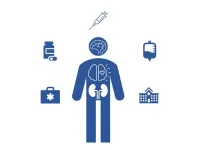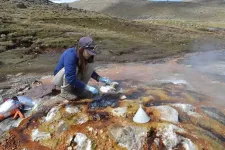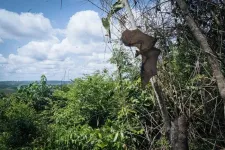(Press-News.org) Children and teenagers who volunteer tend to flourish mentally and physically, according to a new study from UTHealth Houston.
The study, led by Kevin Lanza, PhD, assistant professor of epidemiology, human genetics, and environmental sciences at UTHealth Houston School of Public Health, was published recently in JAMA Network Open.
Overall, the research team found that youths who had volunteered in the past year were in better physical health, had a more positive outlook on life, and were less likely to have anxiety, depression, or behavioral problems compared to their peers who did not volunteer.
“These study results bring optimism that youth volunteering could be a win-win, where youth are serving society to their own benefit,” said Lanza, who is based in Austin. “Further, youths may be joined by household members and others while volunteering, strengthening social bonds while building community.”
The positive effects of volunteering on the health and well-being of adult volunteers is well-established, and two past studies with small sample sizes have shown that teen volunteers may be in better health, and more engaged at school, than their peers. However, Lanza said the effect of volunteering on youths remained largely unknown, inspiring him to launch the study.
Lanza’s team analyzed parent-reported data from a long-running national survey tracking the health and well-being of U.S. children and teenagers, focusing on nearly 52,000 children and teens ages 6 to 17 who were surveyed from 2019-2020. Of those respondents, one-third of children and just over half of teens had done volunteer work in the past year.
Parents whose kids volunteered were 33% more likely to say their child was in “very good” to “excellent” health compared to parents whose kids did not volunteer. Those parents were also between 18% and 35% less likely to say their child had battled depression or anxiety, or had behavioral problems, in the past year.
Moreover, children and teens who did volunteer work were 66% more likely to be “flourishing” – defined based on how parents answered questions about their kids’ curiosity, willingness to complete tasks, and ability to stay calm when faced with challenges.
One limitation of the study is potential response bias from parent-reported data. Furthermore, researchers noted, the study results do not answer the question of whether kids who were already healthy and flourishing were more likely to volunteer. Lanza hopes to explore the cause-and-effect relationship of volunteering on kids’ health and well-being more in the future.
“There is a wealth of volunteering options for youth in different settings – parks, schools, hospitals – and with different purposes, such as environmental conservation or health promotion,” he said. “Volunteer experiences may help shape values and interests in youth that track into adulthood.”
Co-authors with UTHealth Houston School of Public Health included Austin-based researchers Ethan Hunt, PhD; Dale Mantey, PhD; Onyinye Omega-Njemnobi, MBBS; Benjamin Cristol, MPH; and Steven Kelder, PhD.
END
Study: Doing good for others is good for children’s and teens’ mental, physical health
2023-06-06
ELSE PRESS RELEASES FROM THIS DATE:
Health equity is the focus of LBGTQ+ Pride Month celebrations across the country
2023-06-06
DALLAS, June 6, 2023 — According to a study recently published in the Journal of the American Heart Association, lesbian and bisexual women in France had poorer heart health than heterosexual women, a finding that could be attributed to discrimination and other stressors faced by the LGBTQ+ community. In support of Pride Month, the American Heart Association, a global force for longer, healthier lives for all, is promoting awareness and health education for all people across the spectrum of diversity, including those who identify as LGBTQ+.
For more than 50 years, the LGBTQ+ community has spent the month of June ...
Order in chaos: Atmosphere’s Antarctic oscillation has natural cycle
2023-06-06
HOUSTON – (June 6, 2023) – Climate scientists at Rice University have discovered an “internally generated periodicity” — a natural cycle that repeats every 150 days — in the north-south oscillation of atmospheric pressure patterns that drive the movement of the Southern Hemisphere’s prevailing westerly winds and the Antarctic jet stream.
“This is something that arises from the internal dynamics of the atmosphere,” said Pedram Hassanzadeh, co-author of a study about the discovery in the open-access journal AGU Advances. “We were playing with some new equations that we had derived ...
Recent papers in ACS Measurement Science Au
2023-06-06
ACS Measurement Science Au is a member of the ACS Au family of journals. These publications are open access, and each one focuses on a specific field relevant to chemistry. Here, we take a look at a few recent papers from ACS Measurement Science Au, which publishes experimental, computational or theoretical research in all areas of chemical measurement science. The journal welcomes papers on any phase of analytical operations, such as sampling, measurement and data analysis.
“Colorimetric Signal Readout for the Detection of Volatile Organic Compounds Using a Printable Glass-Based ...
Two brain mechanisms for picking speech out of a crowd
2023-06-06
Researchers led by Dr. Nima Mesgarani at Columbia University, US, report that the brain treats speech in a crowded room differently depending on how easy it is to hear, and whether we are focusing on it. Publishing June 6th in the open access journal PLOS Biology, the study uses a combination of neural recordings and computer modeling to show that when we follow speech that is being drowned out by louder voices, phonetic information is encoded differently than in the opposite situation. The findings could help improve hearing aids that work by isolating attended speech.
Focusing on speech in a crowded room can be difficult, especially ...
Does multimorbidity impact chronic disease treatment?
2023-06-06
Treatment efficacy for a broad range of chronic diseases does not differ depending on patients’ comorbidities, according to a new study publishing June 6th in the open access journal PLOS Medicine by David McAllister of the University of Glasgow, UK, and colleagues.
There is often uncertainty about how treatments for single conditions should be applied to people who have multiple chronic conditions (multimorbidity). This confusion stems, in part, from the fact that people with multimorbidity are under-represented in randomized controlled trials, and trials rarely report whether the efficacy of treatment ...
Finding clues about the process of cell plasticity
2023-06-06
Researchers have long thought that once a cell starts down its path of differentiation, growing into a skin cell or a liver cell or a neuron, that path could not be changed.
But over the past two decades, scientists have realized this pathway is more complex. Now, using zebrafish as a model, a University of Michigan research team has discovered that a loop in the body's mitochondria—organelles within cells that produce energy for the body—may allow cells to retreat up the path of differentiation. Their results are published in the Proceedings of the National Academy of Sciences.
"Cell fate and differentiation ...
Tectonics matter: USU geoscientists probe geochemistry, microbial diversity of Peruvian hot springs
2023-06-06
LOGAN, UTAH, USA -- South America’s Andes Mountains, the world’s longest mountain range and home to some of the planet’s highest peaks, feature thousands of hot springs. Driven by plate tectonics and fueled by hot rock and fluids, these thermal discharges vary widely in geochemistry and microbial diversity.
Utah State University geoscientists, along with colleagues from Montana State University, examined 14 hot springs within the southern Andes in Peru and discovered microbial community composition is distinctly different in two tectonic settings. Dennis Newell, associate professor in USU’s Department of Geosciences, and recent USU graduate Heather Upin, ...
To prevent future pandemics, leave bats alone
2023-06-06
A new paper in the journal The Lancet Planetary Health makes the case that pandemic prevention requires a global taboo whereby humanity agrees to leave bats alone—to let them have the habitats they need, undisturbed.
Like the SARS coronavirus outbreak of 2003, the COVID-19 pandemic can be traced back to a bat virus. Whether someone handled or ate an infected bat or was exposed to a bat’s bodily fluids in a cave or some other way, or was exposed to another animal that had been infected by a bat, we will quite likely never know. Even a virus released via a lab accident would still have originally come from ...
Investments advance brain research, name MRI for longtime BrainHealth couple
2023-06-06
The Laurie and Todd Platt BrainHealth Project MRI Scanner will help researchers identify neural markers of improved brain health
Center for BrainHealth® celebrates major contributions reaching more than $1 million to support discoveries of brain improvement biomarkers. This investment in advancing the science of brain health is made possible by Sarah and Ross Perot, Jr., Laurie and Todd Platt and many of their friends.
The Sammons BrainHealth Imaging Center is dedicated to discovering a scalable panel of brain measurements correlating physical changes in the brain with changes in a holistic composite metric of brain ...
Nebraska scientists closing in on long-lasting swine flu vaccine
2023-06-06
A successful long-term experiment with live hogs indicates Nebraska scientists may be another step closer to achieving a safe, long-lasting and potentially universal vaccine against swine flu.
The results are not only important to the pork industry, they hold significant implications for human health. That’s because pigs act as “mixing vessels,” where various swine and bird influenza strains can reconfigure and become transmissible to humans. In fact, the 2009 swine flu pandemic, involving ...






